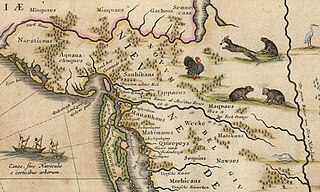
New Amsterdam was a 17th-century Dutch settlement established at the southern tip of Manhattan Island that served as the seat of the colonial government in New Netherland. The initial trading factory gave rise to the settlement around Fort Amsterdam. The fort was situated on the strategic southern tip of the island of Manhattan and was meant to defend the fur trade operations of the Dutch West India Company in the North River. In 1624, it became a provincial extension of the Dutch Republic and was designated as the capital of the province in 1625.

New Sweden was a colony of the Swedish Empire along the lower reaches of the Delaware River between 1638 and 1655 in present-day Delaware, Maryland, New Jersey, and Pennsylvania in the United States. Established during the Thirty Years' War when Sweden was a great power, New Sweden formed part of the Swedish efforts to colonize the Americas.

New Netherland was a 17th-century colonial province of the Dutch Republic located on the east coast of what is now the United States of America. The claimed territories extended from the Delmarva Peninsula to Cape Cod. Settlements were established in what became the states of New York, New Jersey, Delaware, and Connecticut, with small outposts in Pennsylvania and Rhode Island.

West Jersey and East Jersey were two distinct parts of the Province of New Jersey. The political division existed for 28 years, between 1674 and 1702. Determination of an exact location for a border between West Jersey and East Jersey was often a matter of dispute.

Johan Classon Risingh was the last governor of the Swedish colony of New Sweden.
This is a list of Directors, appointed by the Dutch West India Company, of the 17th century Dutch province of New Netherland in North America. Only the last, Peter Stuyvesant, held the title of Director General. As the colony grew, citizens advisory boards – known as the Twelve Men, Eight Men, and Nine Men – exerted more influence on the director and thus affairs of province.

Russell Anthony Shorto is an American author, historian, and journalist who is best known for his book on the Dutch origins of New York City, The Island at the Center of the World. Shorto's research for the book relied greatly on the work of the New Netherland Project, now known as the New Netherland Research Center, as well as the New Netherland Institute. Shorto has been the New Netherland Institute's Senior Scholar since 2013.
The New Netherland Institute is a non-profit organization created to support the translation and publication of 17th-century Dutch documents from the period of the Dutch colonization of New Netherland.

Bergen was a part of the 17th century province of New Netherland, in the area in northeastern New Jersey along the Hudson and Hackensack Rivers that would become contemporary Hudson and Bergen Counties. Though it only officially existed as an independent municipality from 1661, with the founding of a village at Bergen Square, Bergen began as a factory at Communipaw circa 1615 and was first settled in 1630 as Pavonia. These early settlements were along the banks of the North River across from New Amsterdam, under whose jurisdiction they fell.
Historic preservation in New York is activity undertaken to conserve forests, buildings, ships, sacred burial grounds, water purity and other objects of cultural importance in New York in ways that allow them to communicate meaningfully about past practices, events, and people.

Fort Nassau was a factorij in New Netherland between 1627–1651 located at the mouth of Big Timber Creek at its confluence with the Delaware River. It was the first known permanent European-built structure in what would become the state of New Jersey. The creek name is a derived from the Dutch language Timmer Kill as recorded by David Pietersen de Vries in his memoirs of his journey of 1630–1633. The Delaware Valley and its bay was called the "South River" ; the "North River" of the colony was the Hudson River. The factorij was established for the fur trade, mostly in beaver pelts, with the indigenous populations of Susquehannock, who spoke an Iroquoian language, and the Lenape, whose language was of the Algonquian family. They also wanted to retain a physical claim to the territory.

Fort Beversreede was a Dutch-built palisaded factorij located near the confluence of the Schuylkill River and the Delaware River. It was an outpost of the colony of New Netherland, which was centered on its capital, New Amsterdam (Manhattan), on the North River.

New Netherland was the 17th century colonial province of the Republic of the Seven United Netherlands on the northeastern coast of North America. The claimed territory was the land from the Delmarva Peninsula to southern Cape Cod. The settled areas are now part of the Mid-Atlantic states of New York, New Jersey, and Delaware, with small outposts in Connecticut and Pennsylvania. Its capital of New Amsterdam was located at the southern tip of the island of Manhattan on the Upper New York Bay.

Jasper Danckaerts was the founder of a colony of Labadists along the Bohemia River in what is now the US state of Maryland. He is known for his journal, kept while traveling through the territory which had previously been part of the New Netherland. Documenting his journey in 1679–1680, it offers a description of the landscape and the lifestyle of inhabitants of the region in the late 17th century.
Firth Haring Fabend is an American novelist and historian. She was born in Tappan, New York, on August 12, 1937, the daughter of James Firth Haring and Elizabeth Adler. She graduated from Nyack High School in Nyack, New York, and is a 1959 graduate of Barnard College, where she majored in English literature. She holds a PhD in American Studies from New York University. She spent her Junior Year at Westfield College of London University. While working in book publishing in New York City and attending graduate school, she published five novels between 1968 and 1985. Three book-length works of history followed in 1991, 2000, 2012 and to date some thirty essays and chapters in books.
Adriaen Jorissen Thienpoint or Tienpoint was a Dutch sea captain-explorer who commanded several ships to the newly developing colonies of New Netherland and New Sweden as well as other holdings of the Dutch Empire in North America in the early 17th century.
The Society of Daughters of Holland Dames is a hereditary organization founded in 1895 whose purpose is to preserve and promote the historical legacy of the seventeenth-century Dutch settlers of New Netherland. The Society sponsors emerging scholars researching New Netherland history. Complementing an initiative by the Holland Society of New York, the Society partnered with the New Netherland Institute (NNI) to promote the availability of online transcriptions and translations of the original seventeenth-century New Netherland administrative records housed at the New York State Library and Archives. The translation of these manuscripts has contributed to an understanding of the impact of the Dutch on the founding of the United States of America and became the historical basis of Russell Shorto's book Island at the Center of the World and many other scholarly works. An up-to-date bibliography appears on the website of the New Netherland Institute. In 2018, the Society published Historical Records 1895-2017 and contributed copies to relevant research libraries. In 2020, the Society updated and copyrighted Researching Your Dutch Ancestors: A Practical Guide.
Founded in 1916, the Columbia County Historical Society and CCHS Museum & Library collects, preserves, interprets, and presents the history, heritage, and culture of Columbia County, New York, and serves residents of all eighteen Columbia County towns and the city of Hudson.









